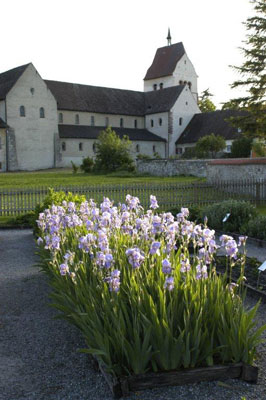Reichenau’s medieval medicinal garden
This item appears on page 58 of the October 2011 issue.
An Alps-backed setting, fairy-tale villages and a benign climate have long contributed to Lake Constance’s reputation as a compelling southern Germany travel destination. To that list, I had another reason to make my way to Europe’s third-largest body of water: gardens, including an entire island turned spectacular garden, Mainau.
From the medieval town of Konstanz, where I headquartered my fall 2010 stay, I stepped aboard one of the ferry shuttles that crisscross the 208-square-mile-lake. En route, I marveled at Lake Constance’s efficient water-transportation system that ensures relaxing and scenic shortcuts to almost anywhere one might want to go.
Stepping ashore on Mainau, I was not disappointed and happily spent the day steeped in spectacular flowery displays, manicured woods, gigantic topiaries, a greenhouse filled with exotic palms, a blossom-filled butterfly enclosure, fountains, a spectacular man-made cascade, a castle and, thrown in for good measure, a baroque chapel.
Mainau, however, is not the garden that remains in my mind. That would be a small, unprepossessing garden created by a ninth-century monk, the garden of Walahfrid Strabo, known as Walahfrid the Squinter, on another of Lake Constance’s islands, Reichenau.
Reichenau is reached not by ferry but by an 1838-built, tree-lined causeway interrupted by a bridge that allows ordinary boats other than those with masts to pass through.
Like Mainau, the island’s focus is gardens, but here the horticultural assortment ranges from asparagus to zucchini, with some 100 family businesses producing an annual 18,000 tons of fresh vegetables on a cultivated 160 hectares. Fifty hectares of greenhouses extend the growing season.
Some 20 hectares of vineyards represent a return to the cultivation of wine grapes that flourished on the island during the Middle Ages.
In 724, Reichenau was uninhabited when an itinerant bishop received the consent of the Franconia royal court to take possession of the entire island for a monastery. In the early Middle Ages, the monastery reached its peak — politically, scientifically and culturally — with more than 20 churches and chapels on the island.
Only three have survived the centuries, superb examples of Romanesque monastic architecture. Magnificent wall paintings underscore Reichenau’s importance to the history of European art. So many remnants of the rich, monastic heyday of the Middle Ages remain throughout the island that in 2000 Reichenau in its entirety was named a UNESCO World Heritage Site.
Reason enough for me to make my way to the island, even had I not had a copy of Walahfrid the Squinter’s “Hortulus,” translated from the Latin as “Little Garden,” in hand.
One of the three remaining churches is the magnificent monastery church of St. Maria and St. Markus. It was there that Walahfrid, renowned poet and Latin scholar, served as abbot between 842 and 849.
As abbot, Walahfrid was responsible for the health of those living at the monastery. With his active participation, a medicinal garden was planted. Most importantly, he set about documenting the garden. The end result was the slim volume I’d brought with me in the slight hope that some remnant of this garden might be.
Acknowledged today as one of the world’s first garden books and the very first to describe a monastery medicinal garden, “Hortulus,” is readily available today from such sources as Amazon.com.
A preface explains how the abbot gained his gardening knowledge: “I myself learned this, not solely from opinion, common report, nor from searches of books and early writings, but by work and hands-on study to discover proven methods — which considerably postponed my leisure at the end of each day!”
One can imagine him in candlelight, bent over his penning — Walahfrid the Squinter.
He wrote of the garden’s beginning in early spring, expressing dismay at the nettles “pushing up everywhere in my small plot.” He described the growing of some plants from seed, others from cuttings, and the hauling of water in a bucket, pouring it “drop by drop, careful not to float the seeds away.”
In exquisite poetic detail, yet in a charmingly human and unpretentious way, he described the orderly rows of rectangular beds, garden care and plant usage. He wrote of sage, “sweet in smell, full of effective powers and healing to drink”; lily, which when “rubbed mashed on snake bite is healing,” and nepeta, which “closes wounds, restores hair loss.”
Fingers crossed, I arrived at the cathedral of St. Maria and St. Markus. Yes, if I’d follow the path through the field to one side of the church I’d find a reproduction of the garden.
His Little Garden! Orderly rows of rectangular beds, meticulously labeled, with 15 of the 24 medicinal plants described in “Hortulus” represented.
Had I visited in summer, Walahfrid’s garden would have shown herbs in flower, lilies and roses in bloom, bees busily buzzing about. But this was late fall. And while the gardens at Mainau are planted and replanted to ensure gorgeous displays for its thousands of visitors in any season — dahlias the unquestionable autumn star — this little garden had retreated to brown repose, its purpose as a medicinal garden completed for the year.
No matter, this was a garden of historical importance, this was a garden with a story to tell, this was the Lake Constance garden that, to me, remains unforgettably enchanting.

